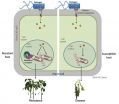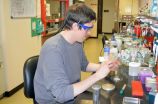(Press-News.org) One of the reasons pluripotent stem cells are so popular in medical research is that they can be differentiated into any cell type. However, typical differentiation protocols lead to a heterogeneous population from which the desired type must be purified. Normally, antibodies that react to surface receptors unique to the desired cell are used for this purpose. However, in many cases the purification levels remain poor and the cells can be damaged. New RNA technology produced at CiRA may avoid these problems.
Professor Hirohide Saito at the Dept. of Reprogramming Science is a bioengineer who makes tools for iPSC researchers. His latest technology, the microRNA (miRNA) switch, is designed to detect and sort live cells not by surface receptors, but by miRNAs. miRNA is a better marker of cell types and can therefore improve purity levels. His miRNA switches consist of synthetic mRNA sequences that include a recognition sequence for miRNA and an open reading frame (ORF) that codes a desired gene, such as a regulatory protein that emits fluorescence or promotes cell death. If the miRNA recognition sequence binds to miRNA expressed in the desired cells, the expression of the regulatory protein is suppressed, thus distinguishing the cell type from others that do not contain the miRNA and express the protein.
Senior Lecturer Yoshinori Yoshida is a cardiomyocyte specialist also at the Dept. of Reprogramming Science who immediately saw the potential of this technology. He has been studying how iPS cells can be used to combat cardiac diseases, but has been stymied by unsatisfactory purity levels. Cardiomyocytes are especially difficult to purify because they do not express unique surface receptors. The two scientists therefore collaborated to investigate the effectiveness of miRNA switches for these cells.
By applying the miRNA switches to a defined cardiomyocyte cell line, they were able to identify miRNAs unique to cardiomyocytes. From there, miRNA switches that contained sequences complementary to these miRNAs were constructed. The result was far better purification than that achieved by standard methods. Furthermore, because this technology is RNA-based, it does not integrate into the genome, which makes the cells eligible for clinical application.
Yoshida sees this tool as remarkably simple and something that can be used by stem cell researchers studying any organ. "It is just synthesizing RNA and transfecting them. It is not difficult," he said. To prove this point, he and Saito applied their miRNA switches to the purification of hepatocytes and pancreatic cells, neither of which has unique cell surface markers, finding miRNA switches effective there too.
Intriguingly, the performance of different miRNA switches varied with cell development, suggesting that strategic selection of miRNAs could separate cardiomyocytes at different developmental stages and lead to an even more homogeneous cell pool and potentially better cell therapy outcomes.
Saito believes that with further development, miRNA switches will be applicable to all cell types at all cell stages. "We want to make an active miRNA dictionary for each cell type, so that if we want to isolate this kind of cell type, we know how to use this kind of switch," he said.
INFORMATION:
Reference:
"Efficient detection and purification of cell populations using synthetic microRNA switches."
Kenji Miki, Kei Endo, Seiya Takahashi, Shunsuke Funakoshi, Ikue Takei, Shota Katayama, Taro Toyoda, Maki Kotaka, Tadashi Takaki, Masayuki Umeda, Chikako Okubo, Misato Nishikawa, Akiko Oishi, Megumi Narita, Ito Miyashita, Kanako Asano, Karin Hayashi, Kenji Osafune, Shinya Yamanaka, Hirohide Saito and Yoshinori Yoshida
Receptors carrying built-in decoys are the latest discovery in the evolutionary battle between plants and pathogens. The decoy domains within the receptor detect pathogens and raise the cell's alarm when there is an infection.
Plants display component parts of their immune system on receptors to trick pathogens into binding with them, which then triggers defence mechanisms. The discovery comes from Professor Jonathan Jones' group at The Sainsbury Laboratory, published in the high-impact journal Cell with a companion paper on a similar discovery from the Deslandes group ...
Almost 90 per cent of men with advanced prostate cancer carry genetic mutations in their tumours that could be targeted by either existing or new cancer drugs, a landmark new study reveals.
Scientists in the UK and the US have created a comprehensive map of the genetic mutations within lethal prostate cancers that have spread around the body, in a paper being hailed as the disease's 'Rosetta Stone'.
Researchers say that doctors could now start testing for these 'clinically actionable' mutations and give patients with advanced prostate cancer existing drugs or drug combinations ...
May 21, 2015 - A University of Wyoming faculty member led a research team that discovered a certain type of soil bacteria can use their social behavior of outer membrane exchange (OME) to repair damaged cells and improve the fitness of the bacteria population as a whole.
Daniel Wall, a UW associate professor in the Department of Molecular Biology, and others were able to show that damaged sustained by the outer membrane (OM) of a myxobacteria cell population was repaired by a healthy population using the process of OME. The research revealed that these social organisms ...
When Dolphin was a typhoon on May 16, NASA's CloudSat satellite completed a stunning eye overpass of Typhoon Dolphin in the West Pacific at 0412 UTC (12:12 a.m. EDT). By May 22, Dolphin's remnants were moving through the Northern Pacific.
NASA's CloudSat satellite sends pulses of microwave energy through the clouds, and some of the energy in the pulses is reflected back to the spacecraft. The time delay between when the pulse is sent and when the reflected energy is received back at the spacecraft is mapped into a distance of the cloud from the surface of the Earth, and ...
COLUMBIA, Mo. - Last year, researchers at the University of Missouri published a study on genetic diversity in American black bears in Missouri, Arkansas and Oklahoma and determined that conservation management is needed to maintain healthy populations in the region. Now, those scientists have expanded the study to include black bears throughout North America. They discovered that black bears in Alaska are more closely related to bears in the eastern regions of the U.S. and Canada than those located in western regions. Details from the study revealed ancient movement patterns ...
(PARIS, FRANCE) - Stent thrombosis following urgent angioplasty for acute heart attack occurred in less than 1% of patients in a large, "real-world" registry, regardless of whether the antithrombotic treatment used during the procedure was bivalirudin, heparin alone, or a GP IIb/IIIa inhibitor (typically in combination with heparin).*
However, patients who experienced a stent thrombosis between days 2 and 30, regardless of drug regimen, were more likely to die within one year than were patients who developed stent thrombosis within the first 24 hours of their procedure.
"What ...
Skin pliability and elasticity improved after treatment with onabotulinum toxin (Botox) for mild facial wrinkles and the effect lasted for up to four months, according to a report published online by JAMA Facial Plastic Surgery.
Human skin has three biomechanical features: strength, pliability (the ability to stretch) and elasticity (the ability to recoil). As people age, these properties change and the loss of skin elasticity appears to be the most prominent. Physicians use a variety of methods to reverse the signs of aging and onabotulinum toxin A injections are among ...
Providing personalized education and risk assessment for patients with diabetes when they visit the ophthalmologist did not improve glycemic control as measured by hemoglobin A1c levels compared with patients who received usual care, according to a study published online by JAMA Ophthalmology.
Intensive blood glucose control can reduce the onset and progression of microvascular complications in people with diabetes. However, optimal glycemic control as measured by HbA1c is notoriously difficult to achieve. A potential strategy to improve glycemic control is to leverage ...
A workplace intervention designed to reduce employees' work-family conflict and increase schedule flexibility also has a positive influence on the sleep patterns of the employees' children.
The intervention, Support-Transform-Achieve-Results (STAR), includes training supervisors to be more supportive of their employees' personal and family lives, changing the structure of work so that employees have more control over their work time, and changing the culture in the workplace so that colleagues are more supportive of each other's efforts to integrate their work and personal ...
If a young man is a chronic gambler, the chances are extremely high that he also suffers from depression. This is one of the findings from a study led by Frédéric Dussault of the University of Quebec at Montreal in Canada. Published in Springer's Journal of Gambling Studies, it is the first to investigate the extent to which gambling and depression develop hand-in-hand from the teenage years to early adulthood.
Data were drawn from an ongoing long-term study that began in 1984. It follows a group of 1,162 kindergarten boys from economically disadvantaged areas ...



